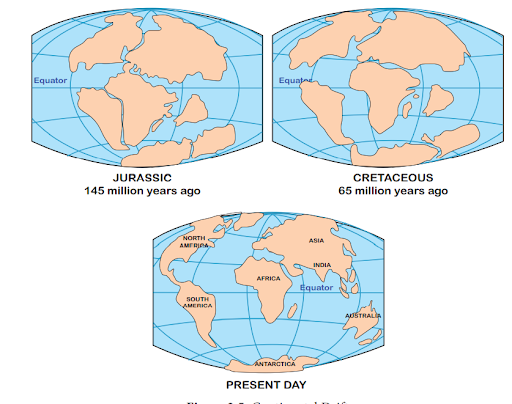Continental Drift Theory UPSC Notes
While Alfred Wegener gets credit for formally proposing Continental Drift in 1912, the idea of continents moving had been around for centuries.
- Continents were once joined together in a supercontinent called Pangaea (all-land) around 200-300 million years ago. Pangaea was surrounded by a giant ocean called Panthalassa (all-sea).
- Pangaea began to break apart due to unknown forces. The initial split formed two major landmasses: Laurasia (northern hemisphere) containing North America, Eurasia, and Greenland; and Gondwanaland (southern hemisphere) containing South America, Africa, India, Australia, Antarctica, and Madagascar. These further drifted and fragmented into the continents we see today.

Wegener proposed two main forces driving continental drift, but they were later found to be insufficient:
- Polar Fleeing Force: The Earth’s bulge at the equator creates a centrifugal force that pushes continents away from the poles towards the equator.

2. Tidal Forces: The gravitational pull of the Sun and Moon on the Earth’s bulge creates frictional forces that cause continents to move.
Evidence for Drift:

-
- Continental Fit: The coastlines of continents like South America and Africa appear to fit together like jigsaw puzzle pieces, suggesting they were once connected.
- Fossil Distribution: Similar fossils of land-dwelling creatures are found on continents now separated by vast oceans, implying they were once part of a single landmass. For example, the reptile Mesosaurus fossils are found in South America and Africa.
- Rock Formations: Identical geological formations are found on continents now far apart, suggesting they were once joined. For instance, the matching sandstone formations across the Atlantic in South America and Africa.
- Paleoclimatic Evidence: Glacial features like striations and tillites found in locations where it wouldn’t occur today based on current continental positions suggest past continental connections. For example, evidence of glaciation in Africa and South America.
Continental Drift’s Legacy
While Continental Drift couldn’t explain the driving force behind continental movement, it laid the foundation for the theory of Plate Tectonics, the current paradigm explaining continental motion. Continental Drift also helps us understand:
- Formation of Mountain Ranges: When continents collide, they crumple and form mountains, like the Himalayas formed due to the collision of the Indian Plate with the Eurasian Plate.
- Volcanic Activity: Boundaries between plates are zones of high heat and tectonic activity, leading to volcanic eruptions.
- Ocean Trenches: When a denser oceanic plate subducts under a less dense continental plate, it creates deep ocean trenches.
Limitations
- Forces: The tidal and polar fleeing forces Wegener proposed lacked the power to move continents the way he envisioned. Scientists couldn’t find evidence to support these forces being strong enough for such large-scale movement.
- Ocean Floor: Continental Drift didn’t consider the ocean floor as a dynamic part of the Earth. It couldn’t explain how continents could move through vast oceans or what happened to the displaced material.
- Speed: Wegener’s estimated speed of continental drift was simply too fast. This raised questions about the feasibility of the theory.